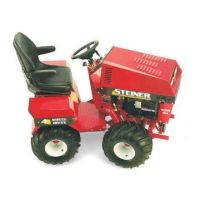IMPORTANT
Safety Practices For Commercial
Turf Care Equipment
I Training
1. Read the Operator’s manual and other training
material. If the operator(s) or mechanic(s) can not
read English it is the owner’s responsibility to
explain this manual to them.
2. Become familiar with the safe operation of the
equipment, operator controls, and safety signs.
3. All operators and mechanics should be trained. The
owner is responsible for training the users.
4. Never let children or untrained people operate or
service the equipment. Local regulations may
restrict the age of the operator.
5. The owner/user can prevent and is responsible for
accidents or injuries occurring to themselves,
other people, or property.
II Preparation
1. Evaluate the terrain to determine what accessories
and attachments are needed to properly and
safely perform the job. Only use accessories and
attachments approved by the manufacturer.
2. Wear appropriate clothing including hard hat, safety
glasses, and ear protection. Long hair, loose
clothing, or jewelry may get tangled in moving
parts.
3. Inspect the area where the equipment is to be used
and remove all objects such as rocks, toys, and
wire which can be thrown by the machine.
4. Use extra care when handling gasoline and other
fuels. They are flammable and the vapors are
explosive.
a. Use only an approved container.
b. Never remove gas cap or add fuel with engine
running. Allow engine to cool before refueling.
Do not smoke.
c. Never refuel or drain the machine indoors.
5. Check that operator’s presence controls, safety
switches, and shields are attached and functioning
properly.
III Operation
Slopes are a major factor related to
loss-of-control and tip-over accidents, which can
result in severe injury or death. All slopes
require extra caution.
1. Never run an engine in an enclosed area.
2. Only operate in good light, keeping away from holes
and hidden hazards.
3. Be sure F-R lever is in neutral, PTO is off, and
parking brake is engaged before starting engine.
Operate all controls from the operator’s seat. Use
seat belts if provided.
4. Slow down and use extra care on hillsides. Be sure
to travel in the recommended directions on
hillsides. Turf conditions can affect the machines
stability. Use caution when operating near
drop-offs.
5. Follow the manufacturers recommendations for
wheel weights or counterweights to improve
stability. (See Section 4, page 4-4; also the
owner's manual for the attachment being used.)
6. Slow down and use caution when making turns and
when changing directions on slopes.
7. Never raise mower deck with the blades running.
8. Never operate with guards not securely in place. Be
sure all interlocks are attached, adjusted properly,
and functioning properly.
9. Never operate mower with the discharge deflector
raised, removed or altered, unless using a grass
catcher.
10. Do not change the engine governor setting or
overspeed the engine.
11. Never leave a running machine unattended.
09-367 2 - 2 rev 12/98
SAFETY section 2

